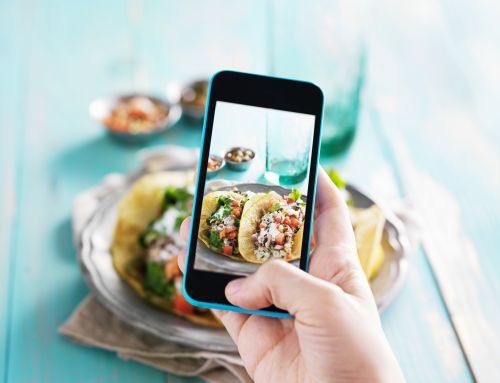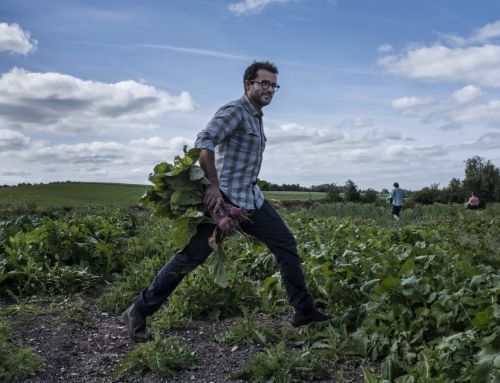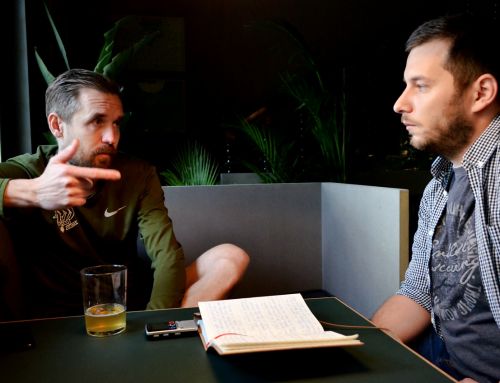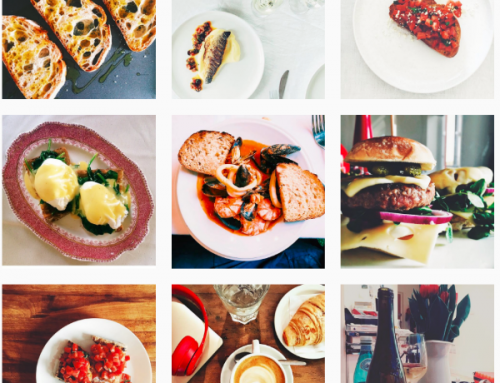
Christian Puglisi / Photo: P.A. Jörgensen
If we would have to recommend you a place in Copenhagen where you need to go right after you exit the airport, it would be Jægersborggade. It is a narrow street that has been featured in every touristic guide, but also one of the most important cultural and culinary spots in the Danish capital. There are less than 500 meters on Jægersborggade and over 40 art galleries, clothing shops, coffee shops, wine bars and restaurants. Even a Michelin starred one.
Back in 2009, when Christian Puglisi, ex Noma sous chef, was looking to open his own restaurant, Jægersborggade was one of the most dangerous streets in Copenhagen and was under the threat of drug dealers and street fights. That was the moment when the community decided to give it a chance. The rents in Jægersborggade have become one of the cheapest in order to encourage small entrepreneurs to open their own businesses in the neighborhood.
Relæ opened one year later, in 2010, as a 90 to 100% organic restaurant. It quickly made the Bib Gourmand list in the Michelin guide, and in 2012 it has received its first star. More than that, in 2015 it debuted in the World’s 50 Best Restaurants list at number 45 and currently sits on number 39.
Today, besides Relæ, Puglisi has three more “children”, as he likes to call his restaurants: a vegetable oriented bistro famous for its beef tartare (Manfreds), a restaurant where pizza is the star (Bæst) and a bakery which serves delicious pain au chocolate (Mirabelle).
We’ve met him on 1st of March, when in Copenhagen was still cold and you couldn’t see many tourists outside. One night before, he was uploading photos with bikes striked by the wind on Instagram. He welcomed us at Mirabelle, the bakery we have read so much about and which we were following on social media. All I can remember now about the beginning of the meeting with Puglisi was his serious face, completely different from what we knew from social media, and a firm handshake. 30 minutes later, we were laughing together and he told us that he enjoyed very much the interview. You can check below what was it about.
What’s your first memory with food?
I was born in Sicily, so a lot of my childhood memories are from there. I believe boiling and preserving tomatoes, aubergine and pasta are my first memories about food.
You’ve opened Relæ in 2010 when you pretty young for a chef (27 years old). How did you decide that it was the time to go on your own?
I already decided that in 2009, when I quit Noma. There, I learned a lot about the whole idea of the restaurant, not only about the kitchen, but at some time I realized that I wanted to do too many things in a different way. I felt it was a sign that I should try to do my own thing.
Speaking about Noma and the previous experience you had also in El Bulli, what have you brought with you when you started to make your own restaurant? Things like philosophy, ideas?
I believe that opening a restaurant is not a result of the experiences, but the beginning of understanding and making your own experiences. When I started cooking, I did it at a battlefield level, which was very useful for me and made me think in a different way. A lot of people who only worked in 2 and 3 Michelin stars restaurants think they do it the right way, but it’s also important to try and understand everything – culinary speaking – if you want to do something that makes a difference. To keep it very short, at El Bulli I understood creativity, because I was very traditionalist. At Noma, besides technical things about food, I looked more into the restaurant. The kitchen was open, I started working with a chef who was really paying attention to how the guests were doing. This wasn’t the case at El Bulli, where I’ve only saw the dining room twice: on my first day and when I came back, two years later.
Regarding the hospitality in Copenhagen, how do you explain that it’s all natural without having to be too stiff?
I think it’s more developed, but you also have to understand that every development comes with a reason. At Relæ, I had to cut down costs on everything possible to give people an experience for an accessible price. Because I didn’t want to reduce the quality of the food itself, I wanted to look at all the technical things within the restaurant and think how much value they bring. For me, things which imply front of house, the technical parts about being a waiter, setting the table or pouring the water bring zero values. I think in my generation we don’t need to be treated in this outdated way. It creates something that is unnatural and don’t make you appreciate the food more.
So what was your solution for this?
Basically, I reduced the options and tried to have an integration between front and back of house. For me, front of house’s main responsibility is to be hospitable: meeting people and talk to them without superficiality. We have this Danish mentality which says that we meet at the same level. Right now at Relæ, we have a service with 2 people at front of house. You would say this is crazy for a restaurant. But we do it at a high level and everybody is doing something all the time. A chef goes to a table, serves the dish, explains it and he’s also taking back dishes when he’s going back. He can also take an order and receive the guests at the door.

Everybody talks about Manfreds as the twin brother of Relæ. What would be your opinion about that?
I see my restaurants as my children. They are from the same family, they have the same values, the same education, but different personalities. So both Relæ and Manfreds are focused on organic produces, mostly vegetables, have similar approach on front of house and hospitality and few options when it comes to menu. But Manfreds is more casual, it’s less strict and with a bigger focus on wine. The food is closely connected to Relæ, because we wanted to connect the restaurants together when we would go and source ingredients. And that’s why Relæ made Manfreds an amazing bistro-level restaurant, while Manfreds also made Relæ a fantastic restaurant. And I give you one tip: at Manfreds we have the highest quality pork that you will find in Denmark and we are the only ones that buy it at a restaurant level. You can also have it at Relæ, but we serve it at Manfreds as the dish of the day for a smaller price. When we buy it, it’s really expensive and more than double the price of the organic pork. But we buy the whole animal and we try to implement the cuts in both places.
How do you decide that a dish is worth to be in your menus?
In order to work creatively, I need to have a goal, a problem solver. If I just say to myself “I want to make a new dish” and start out of nowhere picking ingredients and think of art and nature, nothing happens for me. Let’s say that we have a seasonal menu and for one reason or another, we might want to change some dishes. We look at the options. Let’s suppose that we have potatoes and carrots on the menu. So what’s left? Onions. What can we do with them? What did we do the last time? And all these question lead to a process that will get us somewhere. Otherwise, it’s all about a situation. For example,a few days ago, I ate some chocolate alongside some 5 years old Parmesan and I told Jonathan, our head chef at Relæ, that it’s a really nice combination and that he can try to play with it because of umami and everything. You only need to have your eyes open and think about it.
How did the menus changed since you started the Farm of Ideas?
We added another element: planning. The farm is focused mostly on vegetables and we need to plan ahead. We look at what happened last year, put focus on things that we really liked and adapt our menus. The farm sort of tell us what we need to do. And it’s also available for the proteins, too: we need to decide in which period when we will cook lamb, when we will cook duck and so on.
All the vegetables in your restaurants come from the farm?
Not all. The idea is not be self-sustainable, but to get from the farm the quality that we can’t get anywhere else.
Other plans with the farm?
Today, we have 2 hectares of vegetables. We have 16 cows, 9 calves, 150 egg layers, so we have our own eggs, 4 pigs which will be probably involved in some charcuterie projects later on, we have put crayfish in the water, we are thinking about geese, ducks, also some organic rabbits, which are a rarity in Denmark. I want to move more and more the production on site, to prepare the vegetables there, ferment and preserve things, to have the kitchen staff involved in harvesting, to have the dairy production there. But it’s a process which will take many years.

Photo: P.A. Jörgensen
Speaking about dairy production, you’ve said that you’ve learn to make mozzarella from scratch from Youtube. How did it really happened?
You can learn everything from Youtube, because in this era we’re living right now, you can have access to so much information. So when I was trying to do mozzarella, I traveled, I saw people making it, I’ve read books and I’ve used the internet. I saw many videos about the entire process and tried to put it in practice. Now, I believe the way we are making mozzarella is unique. We don’t say it’s better or worse than others, but it’s unique because it’s the fruit and result of our research, critical understanding, decisions, choices and compromises. In the end, it’s something that I’m very proud of. The milk comes from probably the smallest dairy in the country – like I’ve said before, we have 16 cows at the farm. And the mozzarella is made everyday at 1:30 or 2 PM and then served at 5 PM in the restaurant. I dare you that no restaurant in the world is capable of doing this.
Where did you get your inspiration from?
I don’t think it’s a single thing. I’m a passionate person and I like to be inspired by things that I’ve experienced, by places and restaurants with a completely different mentality. When it comes to food, I think this agricultural element is inspirational. If you only understand food by spending minimum 200 euros for a menu and not as an engine for social change, I think you are losing a lot. If I can cook and do things, work in restaurants, be involved in agriculture and keep connected with more things, I get more inspired. And if I’m inspired, the food that I make also gets better.
Your Instagram post where you criticized that “Best Chefs in the world” list received a lot of positive reactions (n.a. – link here). But how many chefs in the industry really don’t care about these type of lists?
I don’t think a lot. There’s one award after another, one list after another and I’m like: Why? Why do we need another list? I’m against to turning hospitality and cooking into the Olympics. You can not make this thing into a race. If you have the mentality that I have and believe that restaurants are like children, you need to decide what’s best for the child. When you have a restaurant, you really have to know what kind of culinary experience you want to give and it’s your responsibility to have people understand it.
I’m against people and chefs who allow other ones to tell them what’s good or wrong, either we speak about Michelin guide, 50 Best or food critics.
But at the same time, you have a Michelin Star and you’re also included in the 50 best…
Ok, we got a Michelin star, but the great thing was that we never wanted it. Probably it was a strategic decision – I think that Relæ is a great restaurant for the Michelin guide to acknowledge because of its organic focus. Also in the 50s Best – we’ve been in top 100, top 50, number 45, then 40, now 39. If we’re going to get higher, I think it’s going to be dangerous (n.a. laughs). But in the past year, we’ve had less traffic, because Noma has been closed. Does that mean we will go down the list? Probably. But I’m not going to lose my mind to be on the list, because it doesn’t make any sense.
From what we see on Ugly Delicious and other TV food shows, the chefs’ world seems a place where everybody knows everybody, no matter the country and language. Is this a proof that food actually unites people? What is your relationship with other chefs?
Francis Mallmann once said a genius quote: “The reason to eat and drink wine is because it gets us to better conversation”. That is exactly what it is. So of course that food unites people, because it’s something that all of us are influenced by – because we all eat. And in this particular case, also social media unites people. That’s one of the positive things about it. I can follow people, see stuff that they do and write to them. So when they come to Copenhagen, I can invite them in my restaurant. And then I can travel to other places, met other chefs that follow me and that’s how we connect.
You once said that Relæ is opened 4 days per week so you can get to spend more free time with your family. How important is that for a chef so he won’t burnout?
It’s really important. Now I’m in a very privileged position because I really spent all my time doing the stuff I want to do. For me work and life is essentially the same. But when I’m with my son, I only prioritize him: I don’t go to work, I don’t book trips, I spent my entire time with him.
When I’ve started Relæ, the idea was to open 4 days per week so I could be there everyday. Always. For every service. Then I had 3 days off so I can be with my family and relax, plus Easter, Christmas, one month in July and one in January. Then I opened the other restaurants and started to move around, so this model started to get difficult. So we looked at the numbers, added a 5th day, hired one chef and one apprentice more and we had everybody into rotation. Now, the people have their every second weekend off. And here (n.a. – at Bæst and Mirabelle), people work 4 days one week and 3 days the next week
What is your favourite food? What do you like to cook the most at home?
The food that I prefer to cook is the one that have do the least dishes. That is for sure the main criteria (n.a. – laughs).
Which was the happiest moment in your career as a chef?
I don’t think it’s fair to choose just one moment. I believe in complexity. I’ve lived amazing emotions with many things, but I’m also person that develops. To experience something in 2010 it’s completely different than in 2016. I don’t have one happy moment. Today, I am extremely proud and privileged that I have a certain degree of liberty. I can do what I want everyday and to me that is my biggest achievement.
Do you travel for food?
I think it’s more like food makes me travel. I would like to answer “yes” to that question, but I spend a lot of time trying to limit my traveling. I really enjoy it, but with all the stuff I’m doing, I need to have continuity. And if I break up things all the time, it gets difficult. But I love to travel and to be in the context of it. I will go to Australia in April, we’re going to cook a dinner, see the best producers, meet some great chefs. I want to make sure that it will be really inspiring and it will give me something and not just be a public relations event. But except for these kind of trips, I’ve rarely find the time lately to arrange myself a trip for inspiration and just go somewhere to eat. I’ve done it, of course, and I love it – I remember that the year before we opened Bæst we were like 5 guys going to Rome and Naples and other cities on the road.
What is your most recent memorable culinary experience?
I was visiting Slow Food, in Bra, close to Turin, and we had dinner at a 3rd generation restaurant. It was me, Alessandro, my partner at Relæ, that has been going to the Slow Food University, Carlo Petrini, the Slow Food founder, some young people that were connected to the Slow Food University and my two chefs that I brought there to do the event. We had amazing food and we drink wine from this guy’s cellar – a Barollo that you cannot buy anywhere else. I can’t even remember what food we ate, but I can tell you that it was a very memorable dinner, just to sit and discuss with Carlo Petrini and these guys about the times they were young in Piedmont. It was a really special moment.

Which are your favourite 5 places to eat around the world?
One has to be Pepe in Grani, Franco Pepe’s restaurant in Caiazzo, which serves probably the best pizza in the world.
Then I have to say Noma. I haven’t been to the new one yet, but for me it’s a restaurant that changed things.
Faviken is that place where you go with high expectations and they have the confidence to deliver a very simple, beautifully cooked, high quality food. Those people have guts. Because they have clients from all around the world who fly to Trondheim, then drive 2 and a half hours through the middle of nowhere and they serve them a piece of steam turbot with a little sauce. That means that they know what they’re doing. And the quality is definitely up there.
Contramar in Mexico City is a seafood restaurant, crazy big, but with a soul and a vibe that is outstanding. I totally love it. You can have tostada with avocado, shellfish, sea urchins. All incredibly fresh and truly Mexican.
Mocoto in Sao Paulo is a Brazilian restaurant runned by Rodrigo Oliveira. It’s a place close to a favela, so you need to go there with a driver. It’s a restaurant where they care about all the details and select the beans to be the same size, but where you can also see a bus driver that eats there. For me, that’s diversity and true gastronomy.
Your favourite day of eating and drinking in Copenhagen?
I’m very biased, so I would start at Mirabelle for breakfast, have lunch at Manfreds, dinner at Relæ and then I would go to Rudo for drinks.







Leave A Comment